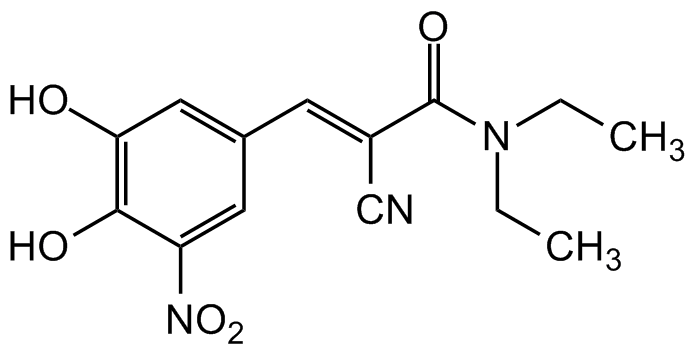Entacapone
| Code | Size | Price |
|---|
| AG-CR1-3708-M005 | 5 mg | £35.00 |
Quantity:
| AG-CR1-3708-M025 | 25 mg | £70.00 |
Quantity:
Prices exclude any Taxes / VAT
Overview
Antibody Isotype: n/a
Antibody Clone: n/a
Regulatory Status: RUO
Shipping:
Ambient
Storage:
-20°C
Images
Documents
Further Information
Alternate Names/Synonyms:
OR-611; (E)-2-Cyano-3-(3,4-dihydroxy-5-nitrophenyl)-N,N-diethylacrylamide
Appearance:
Yellow powder
CAS:
130929-57-6
EClass:
32160000
Form (Short):
liquid
GHS Symbol:
GHS07
Handling Advice:
Keep cool and dry.
Hazards:
H315, H319, H335
InChi:
InChI=1S/C14H15N3O5/c1-3-16(4-2)14(20)10(8-15)5-9-6-11(17(21)22)13(19)12(18)7- 9/h5-7,18-19H,3-4H2,1-2H3/b10-5+
InChiKey:
JRURYQJSLYLRLN-BJMVGYQFSA-N
Long Description:
Chemical. CAS: 130929-57-6. Formula: C14H15N3O5. MW: 305.3. Potent FTO (fat mass and obesity-associated gene) inhibitor for in vivo studies. FTO belongs to the Fe2+ and alpha-ketoglutarate (alpha-KG)-dependent oxygenase family. It demethylates N6-adenosine-modified (m6A) sites and N6,2'-O-dimethyladenosine-modified (m6Am) sites of mRNA. With its demethylase activity, FTO regulates the expression of some uncharacterized genes. The transcription factor FOXO1 has been shown to be a substrate of FTO. FTO demethylated m6A sites on forkhead box protein O1 (FOXO1) mRNA to up-regulate FOXO1 expression, thereby modulating gluconeogenesis and thermogenesis explaining in part the function of FTO on metabolic disorders such as obesity and diabetes. Potent selective and reversible catechol-O-methyltransferase (COMT) inhibitor, an enzyme involved in the metabolism of catecholamine neurotransmitters and related drugs. Entacapone is selective for COMT over monoamine oxidase A (MAO-A) and MAO-B and phenolsulphotransferase M (PST-M) and PST-P (IC50s = >50 µM). It is used for the treatment of Parkinson?s disease, administered concomittantly with levodopa and a decarboxylase inhibitor (e.g. carbidopa). Inhibits alpha-synuclein aggregation in an in vitro assay and blocks alpha-synuclein-induced cell death in PC-12 cells. Shown to uncouple oxidative phosphorylation and inhibit mitochondrial enzyme complexes I and IV. Antioxidant that can scavenge toxic HOCl and ONOO--species and inhibit oxidative stress-induced cell death.
MDL:
MFCD00866580
Molecular Formula:
C14H15N3O5
Molecular Weight:
305.3
Package Type:
Plastic Vial
Precautions:
P261, P280, P302+P352, P312
Product Description:
Potent FTO (fat mass and obesity-associated gene) inhibitor for in vivo studies. FTO belongs to the Fe2+ and alpha-ketoglutarate (alpha-KG)-dependent oxygenase family. It demethylates N6-adenosine-modified (m6A) sites and N6,2'-O-dimethyladenosine-modified (m6Am) sites of mRNA. With its demethylase activity, FTO regulates the expression of some uncharacterized genes. The transcription factor FOXO1 has been shown to be a substrate of FTO. FTO demethylated m6A sites on forkhead box protein O1 (FOXO1) mRNA to up-regulate FOXO1 expression, thereby modulating gluconeogenesis and thermogenesis explaining in part the function of FTO on metabolic disorders such as obesity and diabetes. Potent selective and reversible catechol-O-methyltransferase (COMT) inhibitor, an enzyme involved in the metabolism of catecholamine neurotransmitters and related drugs. Entacapone is selective for COMT over monoamine oxidase A (MAO-A) and MAO-B and phenolsulphotransferase M (PST-M) and PST-P (IC50s = >50 µM). It is used for the treatment of Parkinson?s disease, administered concomittantly with levodopa and a decarboxylase inhibitor (e.g. carbidopa). Inhibits alpha-synuclein aggregation in an in vitro assay and blocks alpha-synuclein-induced cell death in PC-12 cells. Shown to uncouple oxidative phosphorylation and inhibit mitochondrial enzyme complexes I and IV. Antioxidant that can scavenge toxic HOCl and ONOO--species and inhibit oxidative stress-induced cell death.
Purity:
>98% (HPLC)
Signal word:
Warning
SMILES:
OC1=C(O)C([N+]([O-])=O)=CC(/C=C(C#N)/C(N(CC)CC)=O)=C1
Solubility Chemicals:
Soluble in DMSO (30mg/ml), dimethylformamide (30mg/ml) or ethanol (5mg/ml). Insoluble in water.
Transportation:
Non-hazardous
UNSPSC Category:
Other Proteins
UNSPSC Number:
12352200
Use & Stability:
Stable for at least 2 years after receipt when stored at -20°C.
References
Biochemical and pharmacological properties of a peripherally acting catechol-O-methyltransferase inhibitor entacapone: E. Nissinen, et al.; Naunyn Schmiedebergs Arch. Pharmacol. 346, 262 (1992) | Different in vivo properties of three new inhibitors of catechol O-methyltransferase in the rat: P.T. Mannisto, et al.; Br. J. Pharmacol. 105, 569 (1992) | The effect of entacapone (OR-611) on brain [18F]-6-L-fluorodopa metabolism: implications for levodopa therapy of Parkinson's disease: G.V. Sawle, et al.; Neurology 44, 1292 (1994) | Entacapone, a novel catechol-O-methyltransferase inhibitor for Parkinson's disease, does not impair mitochondrial energy production: E. Nissinen, et al.; Eur. J. Pharmacol. 340, 287 (1997) | Entacapone. A review of its use in Parkinson's disease: K.J. Holm & C.M. Spencer; Drugs 58, 159 (1999) | Entacapone and tolcapone, two catechol O-methyltransferase inhibitors, block fibril formation of alpha-synuclein and beta-amyloid and protect against amyloid-induced toxicity: S. Di Giovanni, et al.; J. Biol. Chem. 285, 14941 (2010) | Entacapone is an Antioxidant More Potent than Vitamin C and Vitamin E for Scavenging of Hypochlorous Acid and Peroxynitrite, and the Inhibition of Oxidative Stress-Induced Cell Death: A.Y. Chen, et al.; Med. Sci. Monit. 22, 687 (2016) | The catechol-O-methyltransferase inhibitors tolcapone and entacapone uncouple and inhibit the mitochondrial respiratory chain in HepaRG cells: D. Grunig, et al.; Toxicol. In Vitro 42, 337 (2017) | Identification of entacapone as a chemical inhibitor of FTO mediating metabolic regulation through FOXO1: S. Peng, et al.; Sci. Transl. Med. 11, eaau7116 (2019)



